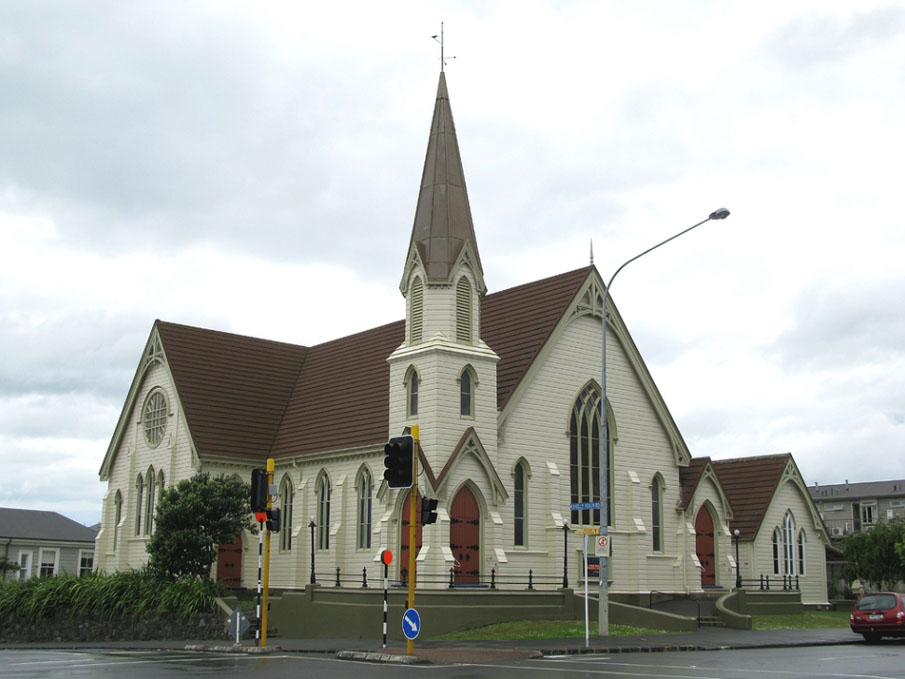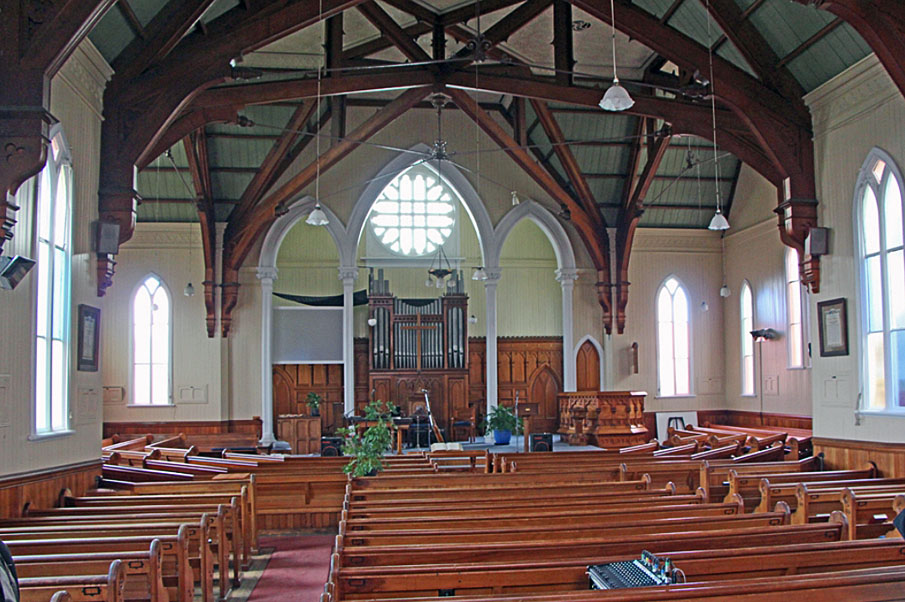Unlike Roman Catholicism, Anglicanism or Wesleyanism, Presbyterianism reached New Zealand as a settler faith rather than as a missionary movement. Rev. John Macfarlane of the First Church of Scotland established the first settler congregation in New Zealand for those of the Presbyterian faith, at Port Nicholson in 1840. From the outset, Presbyterians were among the leaders of the new settlement at Auckland. The first vessels to bring immigrants direct from Britain to Auckland, the Duchess of Argyle and Jane Gifford, arrived in October 1840 with 535 passengers. Both sailed from Greenock, Scotland and their passengers were almost wholly Presbyterians. Members of the faith were well represented among the first public servants in the new capital and among the leading settlers and businessmen. It was not until 1847 (the same year that the Scottish Free Church Lay Association arrived to found the Otago settlement) that any definitive progress was made towards establishing a Presbyterian Church in Auckland. St Andrews opened for divine worship in April 1850. The first minister, Rev. George Ann Panton, left Auckland in late October 1850 after little more than a year, having fallen out with his congregation. Following the arrival of the Rev. David Bruce in June 1853 several charges, fostered by the parent congregation, were formed in and around Auckland. In the earliest days Auckland's population was located chiefly on the eastern side of Queen Street, and the Episcopal, Methodist and Presbyterian Churches were all built on that side. During the 'fifties rapid growth occurred on the western side. The second Presbyterian congregation in the city was established in 1862. St James' Church seating 550, opened in March 1865. In 1876, the Presbyterians took steps to provide a place of worship in the emerging western suburb of Ponsonby, paralleling a similar move by Wesleyans in the same year. Both groups went on to build timber churches in the Gothic Revival style in the suburb, in 1879 and 1882 respectively. There had been an Anglican church on Ponsonby Road since 1866, and the Baptist and Roman Catholic faiths were to each build new churches in the locality in 1885 and 1887. Ponsonby's population of 1,640 in 1874 had more than doubled by 1881, and was to double again by 1886. This was the result of a speculative surge of house-building on Auckland's suburban fringe, which occurred during a protracted economic boom in the 1870s and early 1880s. A new charge, called St Stephen's, was created in Ponsonby in 1876. The congregation's first minister, the Rev. David Runciman from Dunoon, Scotland, was inducted in February 1878. Services were initially conducted in the Ponsonby Hall. The site on which the building now stands was purchased in 1878 for ₤130 and plans were prepared by architect 'Mr Mahoney' for the erection of a building to seat 275 people. The tender of Mr J.W. James, for ₤1,190 for erection of the building, was accepted and the Church was opened on 28 December 1879. The new building was eventually to become part of a larger complex of religious and educational structures built on the site to serve needs of the local Presbyterian community. With the continued growth of the western suburbs, St Stephen's shed part of its parish in 1884 to the new parish of St Peter's. By 1907 there was insufficient space for the ever-increasing numbers attending worship. Sunday school work was being hampered for lack of adequate accommodation and there was, as yet, no official manse. Extension of the church building became the first priority. From October 1906, services were again conducted in the Ponsonby Hall, the church being closed for seven months for enlargement and remodelling. The building's seating capacity was almost doubled to hold 523 worshippers. At a cost of ₤2250, the back section of the church was severed and placed behind the new transept addition. The architect for this work was congregation member Robert Watt, who (by a similar design in 1903-1904) had enabled the enlargement of the Presbyterian Church at Howick (NZHPT registration # 7087, Category II historic place). Watt died, aged 47, two weeks before the Church re-opened for worship on 28 April 1907. The parson's chair on the dais in the sanctuary was presented in his memory as 'Friend and Architect of St Stephen's Church'. Within a few months of completion of the church project, a contract was let for construction of the Sunday school hall at a cost of ₤714. Following its completion in March 1908, a decision was taken to build a manse on church land on the Cameron Street frontage. Eventually a tender for ₤1074 was accepted and the work was put in hand. Completion of the extensive building scheme that the church complex represented was celebrated with a concert in the church for the opening of the new pipe organ. Built in Auckland by well-known organ designer George Croft, the organ was the gift of 'faithful friend of the congregation' who was also one of the church's oldest members, Thomas Peacock. Peacock, an optician and mathematical instrument-maker was an elder of St Stephen's for 40 years, and session clerk for 16 years until 1920. He was a Member of Parliament from 1881 to 1890. In 1910 Peacock took the initiative in a campaign to raise funds for clearing the substantial debt that had been incurred during the extensive building programme of the previous five years, by offering to subsidise any money collected by 50 per cent. By March 1913 the debt had been reduced to ₤375, but the Sunday school hall then had to be enlarged. Abolition of pew rents in 1914 suggests that the church was financially secure by this time. In 1919 a hall to accommodate infant and Bible classes were built (now the remodelled Church lounge). Rapid growth continued so that by 1925 there were over 2000 people under the minister's pastoral care. During the 1920s there was great development in the social and recreational life of the Bible class, which continued until the outbreak of the Second World War (1939-1945). Week-night clubs and fellowship meetings were popular; a gymnasium group was well supported and there were Bible class teams in cricket, athletics, rugby and soccer. The Great Depression of the 1920s and early 1930s severely affected many church families. With the outbreak of the Second World War, most of the men between the ages of 18 and 45 in the congregation joined the armed forces. A baptismal font in the church is dedicated to the memory of the seven congregation members that lost their lives in the conflict, while a lectern honours those who served. Recovery of Bible class membership after the war was slow. Like other churches in the older suburbs of New Zealand's larger cities, St Stephen's suffered a substantial decrease in its congregation following the Second World War. By the 1950s the church exterior required extensive repairs. The manse was subdivided from the site and later sold in 1997 to finance the $300,000 modernisation of the church precinct. Ponsonby architect William Algie was given a brief to create a complex utilising the existing buildings on the site in a manner sympathetic and complementary with the church. The complex provided an administration headquarters, a minister's lounge and reception area. The second stage was to integrate a kitchen block and a new toilet block with the old hall, to better provide for the activities of the congregation and other community groups. The church continues to be used for religious services.



Location
List Entry Information
Overview
Detailed List Entry
Status
Listed
List Entry Status
Historic Place Category 2
Access
Private/No Public Access
List Number
652
Date Entered
6th June 2005
Date of Effect
6th June 2005
City/District Council
Auckland Council
Region
Auckland Council
Extent of List Entry
The registration includes part of the land in RT NA93A/193 (as shown on Map C in Appendix 4) and the church, its fixtures and fittings thereon. The registration does not include the Church Lounge to the east of the church, or the hall to the northeast.
Legal description
Part of Lot 1 DP 155740 (RT NA93A/193), North Auckland Land District
Stay up to date with Heritage this month
